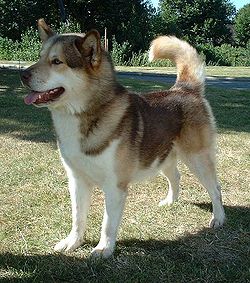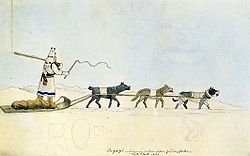- Sled dog
-
 A ten-dog team of Seppala Siberian Sleddogs in tandem hitch on a frozen Mud Lake, a small lake west of Lake Laberge and the Klondike Highway (Photo by Isa Boucher)
A ten-dog team of Seppala Siberian Sleddogs in tandem hitch on a frozen Mud Lake, a small lake west of Lake Laberge and the Klondike Highway (Photo by Isa Boucher)
Sled dogs, known also as sleigh man dogs, sledge dogs, or sleddogs, are highly trained types of dogs that are used to pull a dog sled, a wheel-less vehicle on runners also called a sled or sleigh, over snow or ice, by means of harnesses and lines.
Sled dogs have become a popular winter recreation and sport in North America and Europe; sled dogs are now found even in such unlikely places as Germany and Japan.[1] Several distinct dog breeds are used as sled dogs, however, dog drivers have a long history of using other breeds or crossbreeds as sled dogs. There are two main qualities that are expected in sled dogs: endurance and speed. Racing sled dogs will travel up to an average 20 mph (32 km/h) over distances up to 25 mi (40 km). Although these dogs are very helpful, the origins of this arrangement are unknown.
Contents
History
 Royal Canadian Mounted Police (R.C.M.P.) hitching sled dogs into their harness
Royal Canadian Mounted Police (R.C.M.P.) hitching sled dogs into their harness
Dog power has been utilized for hunting and travel for hundreds of years. As far back as the 10th century these dogs were contributing to human culture.[2]
Dog sled teams are put together with great care. Putting a dog sled team together involves picking leader dogs, point dogs, swing dogs and wheel dogs. The lead dog is very treasured, and seldom will mushers ever let these dogs out of their sight. Indeed, trained lead dogs become part of the family household. Important too is to have powerful wheel dogs to pull the sled out from the snow. Point dogs (optional) are located behind the leader dogs, swing dogs between the point and wheel dogs, and team dogs are all other dogs in between the wheel and swing dogs and are selected for their endurance, strength and speed as part of the team.
Overview
Several distinct dog breeds are in common use as sled dogs, although any sized breed may be used to pull a sled. Purebred sled dog breeds range from the well-known Siberian Husky[3] and Alaskan Malamute[3] to rarer breeds such as the Mackenzie River Husky[3] or the Canadian Eskimo Dog (Canadian Inuit Dog). Dog drivers, however, have a long history of using other breeds or crossbreeds as sled dogs. In the days of the Gold Rush in Yukon, mongrel teams were the rule, but there were also teams of Foxhounds and Staghounds. Today the unregistered hybridized Alaskan Husky[3] is preferred for dogsled racing, along with a variety of crossbreeds, the German Shorthaired Pointer often being chosen as the basis for cross breeding. From 1988 through 1991, a team of Standard Poodles competed in the Iditarod Trail Sled Dog Race.
Sled dogs are expected to demonstrate two major qualities in their work (apart from basic physical capability to pull the sled). Endurance is needed to travel the distances demanded in dogsled travel, which may be anything from 5 to 80 mi (8 to 129 km) or more a day. Speed is needed to travel the distance in a reasonable length of time. Over longer distances, average traveling speed declines to 10 to 14 mph (16 to 23 km/h). In poor trail conditions, sled dogs can still usually average 6 or 7 mph (9.7 or 11 km/h). Sled dogs have been known to travel over 90 mi (145 km) in a 24 hour period while pulling 85 lb (39 kg) each.
Sled dogs pull various sorts of sleds, from the small 25 lb (11 kg) sprint-racing sleds, through the larger plastic-bottomed distance racing toboggan sleds, to traditional ash, freighting sleds and the trapper's high-fronted narrow toboggan. Sled dogs are also used to pull skiers, kicksleds and to draw wheeled rigs when there is no snow. They have even been used to pull kick scooters in places where there is a lack of snow, a sport known as dog scootering. Modern teams are usually hitched in tandem, with harnessed pairs of sled dogs pulling on tug lines attached to a central gangline. Trappers in deep snow conditions using the toboggan will hitch their dogs in single file with traces on either side of the line of dogs. Dog teams of some Inuit are run in "fan hitch", each dog having its own tow line tied directly to the sled.[1]
Sled dog breeds
 A typical sled dog breed, such as the Greenland Dog, has a very dense double coat, wide padded feet, erect ears, a curled tail, wedge-shaped head, and a muscular build.
A typical sled dog breed, such as the Greenland Dog, has a very dense double coat, wide padded feet, erect ears, a curled tail, wedge-shaped head, and a muscular build.
- Alaskan Husky is not a breed, but a category or type of dog.
- Alaskan Malamute was originally bred to be used as an Alaskan sled dog. It is generally a large and domesticated dog.
- Canadian Inuit Dog is an Arctic breed and is considered to be the oldest and rarest of the remaining purebred indigenous domestic canines.
- Chinook is a rare New England sled dog breed of "in-between" type, neither a sprinter nor an endurance freighter; the original lead dog "Chinook" on whom the breed is based was a mixture from working sled dog lines and of a more mastiff-type build than most sled dogs, and the breed varies in appearance much more than most sled dog breeds and often superficially resembles a yellow German Shepherd Dog mix.
- Eurohound is a crossbred dog, a mix between the Alaskan Husky and the Pointer. It has both the Alaskan Husky's sledding ability and the Pointer's enthusiasm and athleticism. It is one of the most formidable sprint-racing sled dogs in the world.
- Greenland Dog is a large breed of husky-type dog kept as a sled dog and also used for hunting polar bear and seal.
- Greyster sled dog type bred in Norway.
- Labrador Husky was bred as a strong, fast, working sled dog and originated in Canada.
- Mackenzie River Husky is built for heavy freighting in single file through deep snow. Less a specific breed than a certain set of varieties of sled dog types from a specific geographic area, a mix of Arctic and subarctic sled dogs.
- Sakhalin Husky is rarely used and usually lives in Japan.
- Samoyed is a pure or mostly-white spitz that was used for herding reindeer as well as pulling sleds.
- Seppala Siberian Sleddog is active and energetic, sharing the same ancestral base as the Siberian Husky.
- Siberian Husky originated in Siberia. They were originally meant to be sled dogs, but nowadays are mainly family pets and show dogs.
- Tamaskan Dog originated in Finland and bred to look like wolves. Not bred specifically for (though still capable of) sledding work, it excels in agility, obedience, and working trials.
- Utonagan and Northern Inuit Dog are bred to resemble wolves, but are mixes between the Alaskan Malamute, German Shepherd, and Siberian Husky.
There were ten distinct husky breeds differentiated by region, height/weight and color: the Husky proper (recognised by the American Kennel Club under the name of Eskimo), the Alaskan Malamute, the Toganee, the Mackenzie River Husky, the Timber-Wolf Dog, the West Greenland Husky, the East Greenland Husky, the Baffinland Husky, the Chuchi (recognised by the American Kennel Club as the Siberian Husky), and the Ostiak.[3]
The Husky or Eskimo dog is rare outside of the Northwest Territories. These are mostly used by trappers, explorers, Eskimos and Indians; the Hudson Bay traders, Royal Canadian Mounted Police, lumber-jacks, doctors, priests and others generally use what the Indians call the white dogs, or crossbred dogs which are half Husky and half Hound, Great Dane, Newfoundland or any other type that is handy.[3]
The Toganee and Mackenzie River Dogs were closely related to the true Husky and sometimes interbred. The Toganee had longer legs while the Mackenzie River Dog had a longer coat. The Timber-Wolf Dog of the Yukon basin was a first-cross between the true Husky and the timber-wolf and used as a leader or "king" dog. The Baffinland Husky differed from the true Husky in having a black coat with white markings. The West Greenland Husky and the slightly smaller East Greenland Husky both had timber-wolf blood and were sometimes crossed with the Baffinland Husky. The East Greenland Husky (also called the Angmagssalik Husky) was considered the oldest and least diluted type. The comparatively small Ostiak or West Siberian Husky was used not only for sled hauling but also in hunting elk, bear and wolf. The tenth recognised type was the Chuchi (Siberian Husky) first imported into Alaska in 1909.[3]
See also
 Indian Dog sled near Fort Clark. Watercolor by Maximilian zu Wied-Neuwied 1833.
Indian Dog sled near Fort Clark. Watercolor by Maximilian zu Wied-Neuwied 1833.
- Dog sled racing
- Balto
- List of sled dog races
- 1925 serum run to Nome
- Sled dog race at the 1932 Winter Olympics
References
External links
- Mushing Magazine
- Sleddoggin - Resources for sled dog enthusiasts
- Dog Song Kennels - Distance racing kennel
- Sled Dogs
- Siberian Husky Club of NSW Inc (Australia) Dog Sledding
Sled dogs Breeds Categories:- Dog types
- Working dogs
- Dog sledding
- Arctic land animals
- Inuit transport
- Sled dog breeds
Wikimedia Foundation. 2010.

